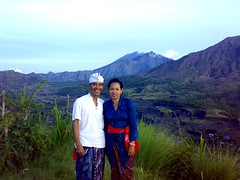 Follow the northern rim of outer crater from where you can take in the wild and rugged beauty of the crater. The road leads to Pinggan on the crater’s north side, the curves southeast to Songan. Through pine forests coffee, clove, orange, and lemon plantations, you will find Pura Penataran Agung Dalem Balingkang just before Belandingan.
Follow the northern rim of outer crater from where you can take in the wild and rugged beauty of the crater. The road leads to Pinggan on the crater’s north side, the curves southeast to Songan. Through pine forests coffee, clove, orange, and lemon plantations, you will find Pura Penataran Agung Dalem Balingkang just before Belandingan. On the way to Pura Dalem Balingkang, is about 1289 above sea level, we can enjoy fantastic view – down under seen village Tabu and Pulu where people take sand and gravel by truck. Some areas they use for farming such onion, tomato, chili paper but mostly was dry and sand and gravel everywhere.
On the way to Pura Dalem Balingkang, is about 1289 above sea level, we can enjoy fantastic view – down under seen village Tabu and Pulu where people take sand and gravel by truck. Some areas they use for farming such onion, tomato, chili paper but mostly was dry and sand and gravel everywhere.There is another access to reach this area from Penelokan, drive down to Toya Bungkah, folloing the edge of Batur lake, Songan village through the north side of the bottom of Batur Volcano. This road is more difficult and worse. The people from north coast arround Tejakula district such as ; Penuktukan, Sambirenteng and Tembok are used to trek to get here.
Ceremonial temple festivals at Pura Dalem Balingkang always take place for a nine to eleven day period during the full moon of Kelima (around November) in accordance to the Balinese saka lunar calendar.
History ;
According to local people, most names of villages are influenced by Chinese. Please take a look closely village name Song An (Songan), Ping Gan (Pinggan), Baling Kang (Balingkang), and Sia Kin (Siakin).To reach the Pura Dalem Balingkang we had to cross a river, but to reach the bridge we had to go down many steps and after having crossed the bridge go up again to reach the Pura Dalem Balingkang. This one is supposed to have existed since the 6th century during the reign of King Jayapangus, a benevolent king, who always paid attention to his subjects. Unfortunately the King had a wicked son who caused the people to hate him. The Queen died of sadness because of her son’s behavior and King Jayapanguswas desperate about his wife death.However, King Jayapangus had a Chinese adviser in his palace. This man, called Empu Liem, advised the King in political and economical affairs and besides, practiced medicine to help the people with their illnesses. He taught the men martial arts, which they in turn, converted to dances. This old man had a female assistant, a beautiful young Chinese girl by the name Kang Cin Wei and this girl was offered to the king as his wife, provided that the King would file his teeth and stop eating raw meat. The King agreed and the two led a happy live. They were often seen walking together and where they came, they would make the people happy and the neighborhood was blessed. They were supposed to bring safety and prosperity in the country. After a few years it was clear that the young woman could not bear children, hence her nickname Dewi Mandul (Barren Goddess).
After their death the people made tall puppets which they would carry in processions preceding important festivals, such as Galungan and the Hari Nyepi. The King is depicted as a dark figure with long teeth, the Dewi Mandul as a fair woman with a wise and merciful expression. Symbolically they are seen as figures that bring prosperity in the country at the same time protecting the places they go from evil spirits.There may be more versions of the tale, which has never been recorded as historical fact but has been passed on from generation to generation. But we can still see the Chinese shrine at the Pura Dalem Balingkang which is supposed to have been named after Kang Chin Wei. Although the pura is located at this remote place and one has to go up and down many steps to reach it, the serenity of this location up in the hills is certainly worth to be experienced.
Source: Myra Sidharta

